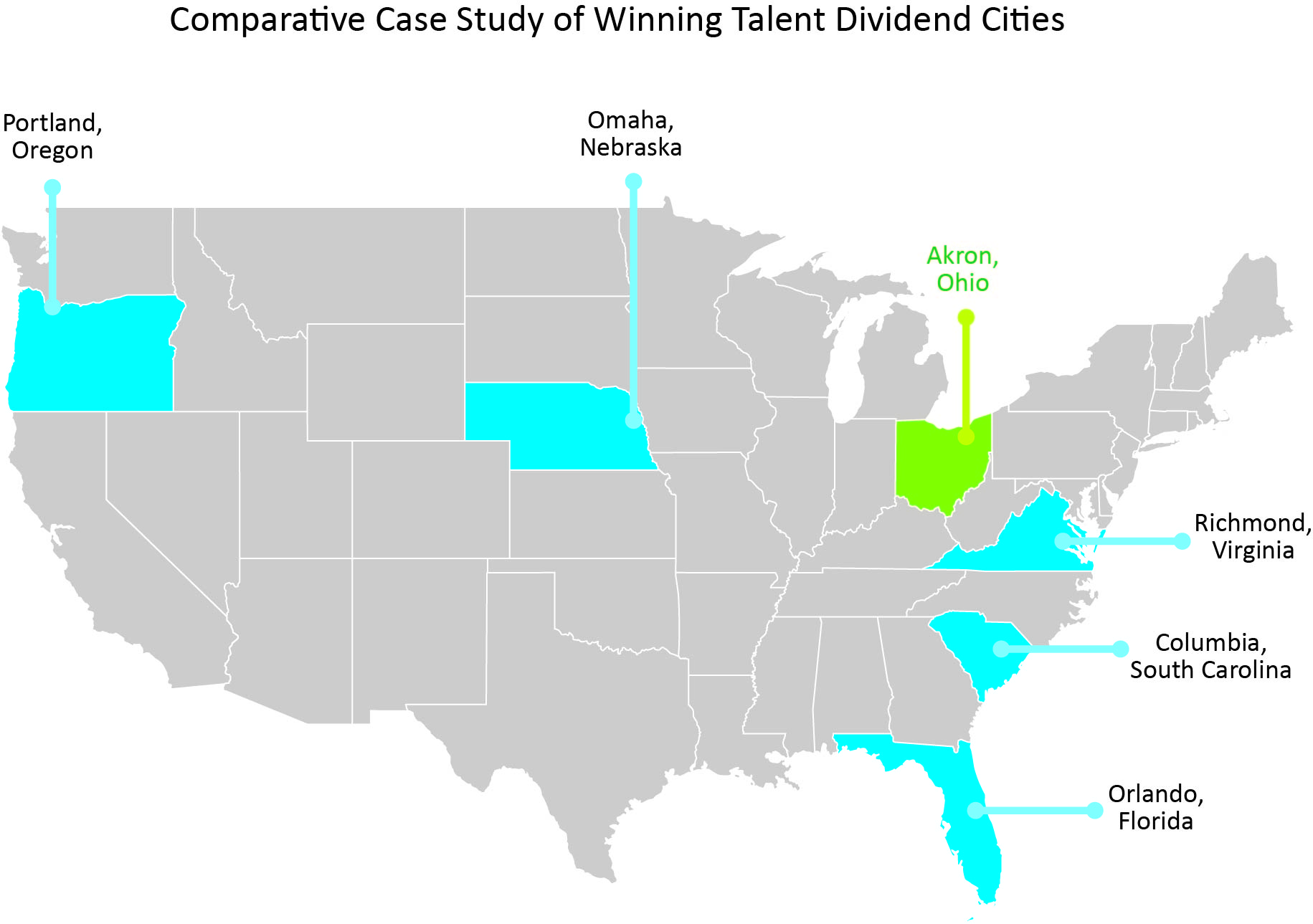Lessons on Increasing College Completion from Six Talent Dividend Cities
Comparative Case Study of Winning Talent Dividend Cities

Overview
Postsecondary education has become a centerpiece strategy for improving America’s labor market. It is estimated that 60 percent of American jobs will require some form of postsecondary education by 2018, and those who have not earned a college degree are 55 percent more likely to be unemployed than those who have. As a result, stakeholders ranging from the White House to state governments to national funders have been pushing colleges and communities to dramatically increase their postsecondary credentialing rates.
The Kresge Foundation joined this call in 2011 by funding a million-dollar prize competition, Talent Dividend, for the U.S. metropolitan area that had the greatest proportional increase in its postsecondary degree completion rate over a four-year period (2009-2013). Fifty-seven of the United States’ 100 most populous cities joined the competition, and the winner — Akron, Ohio — was announced in October 2014.
MDRC provided a qualitative overview of Akron’s activities in this effort in a memo to the Kresge Foundation in December 2015. Building upon this work, MDRC is now undertaking a qualitative case study analysis of five additional top-ranking Talent Dividend cities to explore what factors may have been influential to their success at improving postsecondary completion. The five cities chosen for this case study are Portland, Oregon; Orlando, Florida; Omaha, Nebraska; Columbia, South Carolina; and Richmond, Virginia.
Additional Project Details
Agenda, Scope, and Goals
The Talent Dividend Comparative Case Study will explore the commonalities and differences among six of the Talent Dividend competitors that had the greatest increase in postsecondary credentialing from 2009 to 2013. A key goal of this investigation will be to identify lessons could be applied in other localities that are interested in increasing their postsecondary completion rates.
This investigation will be guided by the following research questions:
-
How important were contextual factors such as the economy and the labor market, changes to state or local policies, or cross-sector partnerships to cities’ efforts to increase graduation rates? What similarities or differences were there across different cities or city environments?
-
How engaged were postsecondary institutions in the Talent Dividend work? What motivated their engagement? How much did institutions of higher education contribute to each city’s focus on increasing postsecondary credentialing rates?
-
Did interventions that have seen success in other postsecondary settings, such as financial support (for example, emergency scholarships, completion scholarships), accelerated programs, or programs that provide more support services for graduation, seem influential to these cities’ postsecondary graduation rates? Were any other types of special programming or interventions important?
-
What outreach or interventions, if any, did cities develop to reach certain populations, such as low-income students or students of color? Were there specific activities that seemed to help bridge the achievement gap?
-
What lessons can be learned from the top Talent Dividend cities’ work that other cities can use in efforts to increase their postsecondary graduation rates?
- Was the prize competition an effective method for engaging communities in increasing postsecondary education completion rates? What types of institutions (for example, philanthropic, business, higher education, nonprofit) seemed most engaged in or affected by the prize competition? What are the benefits and drawbacks to this type of method?
Design, Sites, and Data Sources
Following its documentation of Akron’s work in the Talent Dividend competition, MDRC’s qualitative case study of five additional top-ranking Talent Dividend cities (Portland, Oregon; Orlando, Florida; Omaha, Nebraska; Columbia, South Carolina; and Richmond, Virginia) will be conducted from summer 2016 through late fall 2017.
The research team will conduct a scan of key organizations that are involved with postsecondary education in each city, including two-year colleges and four-year universities, businesses, nonprofits, philanthropic organizations, and government stakeholders. The team will begin with phone interviews of key leaders within these organizations and then conduct an in-person site visit to each city to learn about their activities in depth. The team will focus on gathering information on particular areas that might influence cities’ postsecondary completion rates, including contextual factors (such as changes to state policies, the economy, or local labor markets) and specific interventions to improve students’ financial or social support toward graduation, as outlined in the research questions.
A final report analyzing the efforts across all six top-performing Talent Dividend cities is scheduled for release in late 2017.






